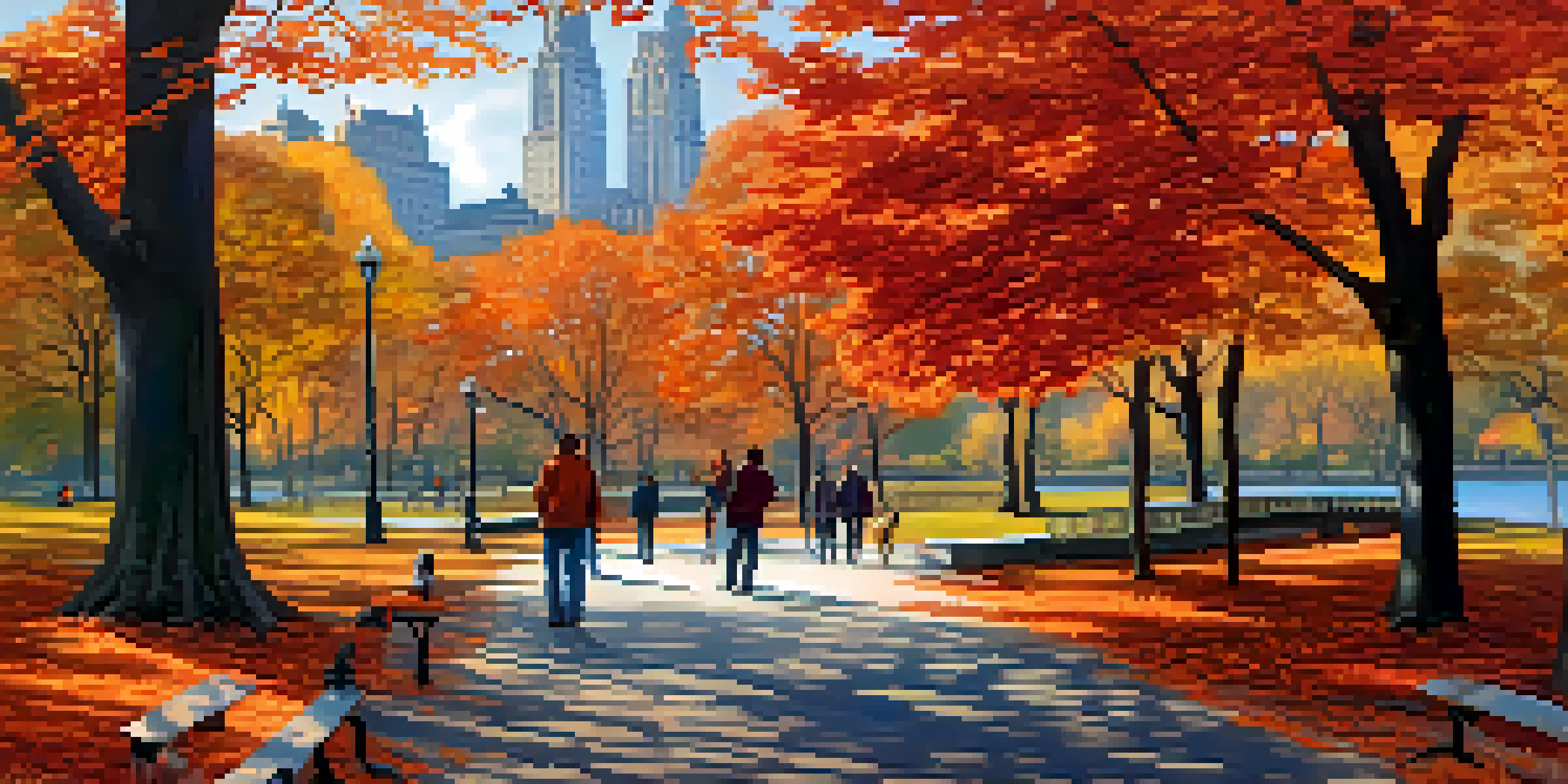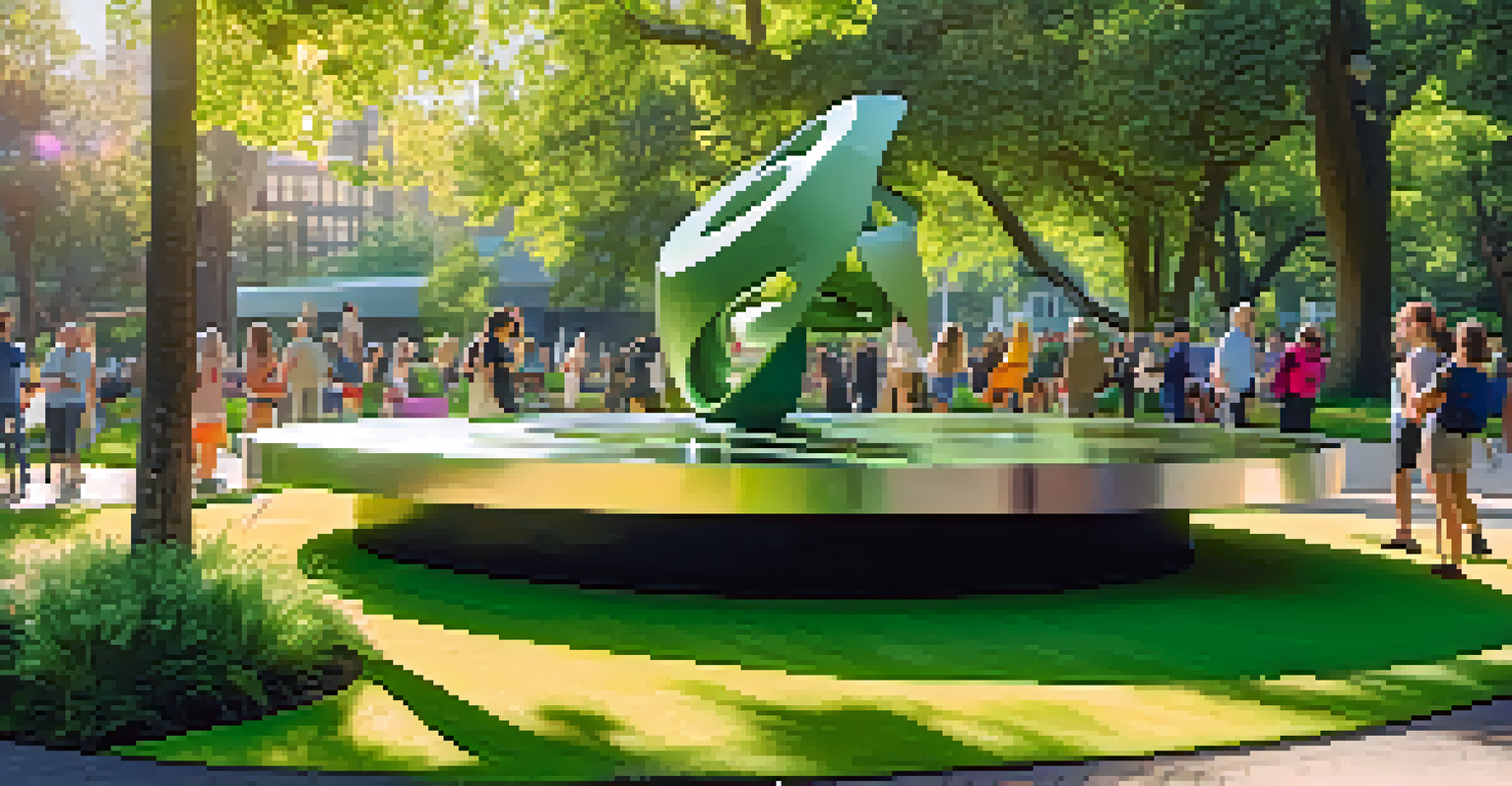Urban Parks: Nature and Culture in NYC's Public Space

The Role of Urban Parks in New York City
Urban parks play a vital role in New York City, offering residents and visitors a refreshing escape from the concrete jungle. These green spaces provide not just a place to unwind, but also a vital connection to nature amidst the hustle and bustle of city life. From Central Park to smaller community gardens, these areas serve as lungs for the city, promoting mental and physical well-being.
The parks are the lungs of the city, providing a breath of fresh air and a connection to nature for all who visit.
Moreover, urban parks act as communal hubs where people from diverse backgrounds converge. They foster social interactions and community bonding, transcending barriers of age, race, and culture. In a city as busy as New York, these parks are essential for creating a sense of belonging and shared experience among its inhabitants.
The integration of art and culture within these parks also enhances their significance. Many parks host performances, art installations, and cultural events that reflect the city's rich diversity. This melding of nature and culture creates an environment that not only nurtures the body but also enriches the soul.
Central Park: A Historic Urban Oasis
Central Park is perhaps the most iconic urban park in New York City, spanning 843 acres of lush landscapes and recreational areas. Designed in the 1850s, it was a revolutionary concept that transformed how urban spaces could incorporate nature. Today, it serves as a sanctuary for millions, with its winding paths and serene lakes providing a perfect backdrop for relaxation and recreation.

The park is also a cultural landmark, showcasing an array of attractions like the Central Park Zoo, the Bethesda Terrace, and numerous art installations. These features make Central Park not just a place for leisure but also a vibrant cultural hub. Visitors can enjoy everything from summer concerts to Shakespeare in the Park, making it a cornerstone of New York's artistic community.
Urban Parks: Essential for Well-Being
Urban parks in New York City provide vital green spaces that promote mental and physical health for residents and visitors alike.
Additionally, Central Park's historical significance cannot be overstated. It was one of the first landscaped public parks in the United States, setting a precedent for urban park design nationwide. Its legacy continues to influence how cities integrate green spaces into their planning, promoting a healthier urban lifestyle.
The Community Gardens: Local Treasures
Community gardens are another shining example of how urban parks enhance city life, particularly in neighborhoods with limited green space. These small, often grassroots initiatives are cultivated by local residents who transform vacant lots into vibrant gardens. They not only beautify the area but also provide fresh produce and a communal space for neighbors to gather.
In every walk with nature, one receives far more than he seeks.
These gardens serve as a platform for education and collaboration, where community members learn about sustainability and gardening practices. Workshops on composting, cooking, and environmental stewardship foster a sense of responsibility towards nature. In this way, community gardens promote not just environmental awareness, but also social cohesion among residents.
Moreover, community gardens often reflect the cultural identity of the neighborhoods they inhabit. Many feature plants and crops native to the diverse backgrounds of the gardeners, showcasing the city’s melting pot of cultures. This connection to heritage fosters a deeper appreciation for biodiversity and the importance of preserving local ecosystems.
The Importance of Accessibility in Urban Parks
Accessibility is a crucial aspect of urban parks, ensuring that everyone can enjoy these shared spaces. New York City has made strides in improving access for individuals with disabilities, including wheelchair ramps, tactile pathways, and sensory-friendly environments. These enhancements allow for a more inclusive experience where all New Yorkers can connect with nature and community.
Beyond physical accessibility, urban parks also aim to be welcoming spaces for individuals from all walks of life. Programs tailored to various demographics, such as families, seniors, and youth, encourage diverse participation. By offering activities that cater to different interests and abilities, parks can foster a sense of belonging for everyone.
Community Gardens: Cultural Hubs
Community gardens transform vacant lots into vibrant spaces that foster social cohesion and reflect the cultural diversity of neighborhoods.
Furthermore, accessible parks promote mental health and well-being, particularly for marginalized communities. Green spaces provide an essential escape from urban stressors, allowing individuals to unwind and recharge. This inclusivity not only benefits individuals but enhances the overall health of the community, creating a more vibrant urban environment.
Art in Urban Parks: A Cultural Showcase
Art installations in urban parks serve as a bridge between nature and culture, transforming green spaces into open-air galleries. From sculptures to murals, these artistic expressions enhance the park experience and provoke thought among visitors. They invite people to engage with their surroundings in new and meaningful ways, sparking conversations around art and nature.
Moreover, many urban parks host cultural events, such as music festivals and theater performances, which further enrich the community's artistic landscape. Events like 'Shakespeare in the Park' draw crowds eager to experience high-quality performances in a unique setting. These activities not only entertain but also foster community engagement and pride.
The collaboration between artists and urban planners also emphasizes the importance of creativity in public spaces. By integrating art into park designs, cities can create environments that inspire and uplift. This blend of nature and creativity makes urban parks more than just green spaces; they become vital parts of the city's cultural identity.
Wildlife in the Urban Jungle: A Surprising Connection
Urban parks are not only havens for humans but also serve as crucial habitats for various wildlife species. In a bustling city like New York, parks provide essential green corridors for birds, insects, and small mammals. This unexpected connection between urban life and nature highlights the importance of preserving these green spaces for the ecosystem's health.
Birdwatching in Central Park, for example, has become a popular pastime, attracting avid birders from all over. The park's diverse landscapes create microhabitats that support migratory birds and local wildlife alike. Such interactions remind us that nature can thrive even in the heart of a city, offering a sense of wonder and discovery.
Future of Parks: Innovation & Growth
The future of urban parks in NYC will focus on sustainability, community involvement, and the integration of technology to enhance visitor experiences.
Additionally, the presence of wildlife in urban parks encourages residents to engage with nature. Observing animals in their natural habitats inspires appreciation for biodiversity and fosters a sense of stewardship towards the environment. This connection between people and wildlife ultimately strengthens the bond between urban dwellers and the natural world.
The Future of Urban Parks in NYC
As New York City continues to grow and evolve, the future of urban parks remains a topic of significant interest. With ongoing discussions about climate change and urban sustainability, parks will play an increasingly vital role in promoting ecological health. Innovations in park design, such as green roofs and rain gardens, reflect a commitment to integrating nature within the urban landscape.
Community involvement is also essential in shaping the future of these spaces. Engaging local residents in the planning and maintenance of parks ensures that they meet the needs of the community. This participatory approach fosters a sense of ownership and pride, encouraging ongoing stewardship of public spaces.

Finally, as technology advances, urban parks may incorporate digital elements to enhance visitor experiences. Interactive installations and apps that provide information on flora and fauna can help bridge the gap between nature and technology. By embracing innovation while maintaining their natural essence, urban parks can thrive as dynamic spaces for future generations.